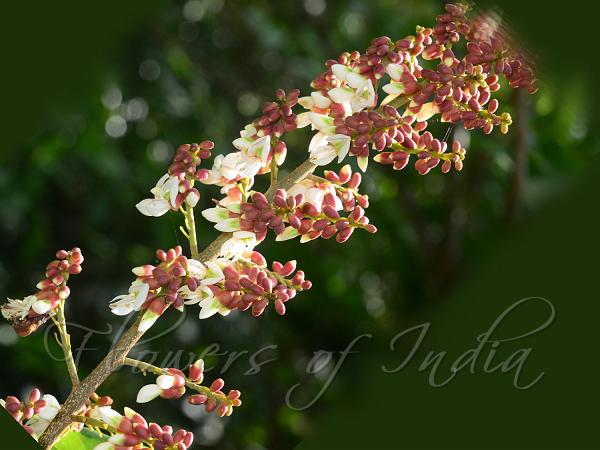|
| East-Himalayan Derris |
|

|

| File size | 354758 |
| Original date | 5/10/19 12:20 PM |
| Resolution | 1500 x 1125 |
| Flash | Flash fired, return detected |
| Focal length | 60.0mm |
| Exposure time | 1/200s |
| Aperture | 10.0 |
| Focus Distance | |
| Metering Mode | Multi-segment |
| Camera make | NIKON CORPORATION |
| Camera model | NIKON D7000 |
| Sensor type | OneChipColorArea |
|
|
|
|
Photo: |
Botanical name: Aganope thyrsiflora Family: Fabaceae (Pea family)
Synonyms: Derris thyrsiflora, Aganope floribunda, Millettia thyrsiflora
Synonyms: Derris thyrsiflora, Aganope floribunda, Millettia thyrsiflora
East-Himalayan Derris is a large climber or a climbing
shrub, with branchlets hairless or very sparsely hairy. Leaves are
5-9-foliolate; axis 30-45 cm, including leaf-stalk 8-14 cm; leaflet
blades oblong to oblong-lanceolate, 10-15 x 3.5-7 cm, subleathery,
both surfaces hairless, secondary veins 5-7 on each side of midvein,
base rounded, tip shortly tapering to sometimes blunt. Flowers are
borne in false panicles in leaf-axils or at branch-ends, narrowly
pyramidal, 12-35 cm, compact, brown or reddish hairy; branches
numerous, rising up or spreading; branchlet nodes with several close
but not fascicled flowers on a short branchlet. Flower-stalks are very
short. Flowers are about 8 mm. Sepal-cup is bell-shaped, about 3 mm,
very sparsely hairy, tip flat or obscurely deltoid toothed. Flowers are
whitish to purplish red, 8-10 mm; standard round, with calluses
heart-shaped at base, notched at tip. Ovary hairy. Legume oblong, 5-10
× 2.5-3(-4) cm, thin, hairless, with prominent netveined veins; both
sutures with a 3-8 mm wide wing. Seeds 1-3 per legume,
oblong-kidney-shaped. East-Himalayan Derris is found in East Himalaya
to China, and SE Asia, at altitudes of 2000 m. Flowering: May-June.
| Identification credit: M. Sawmliana | Photographed in Ailawng area, Mizoram. |
• Is this flower misidentified? If yes,